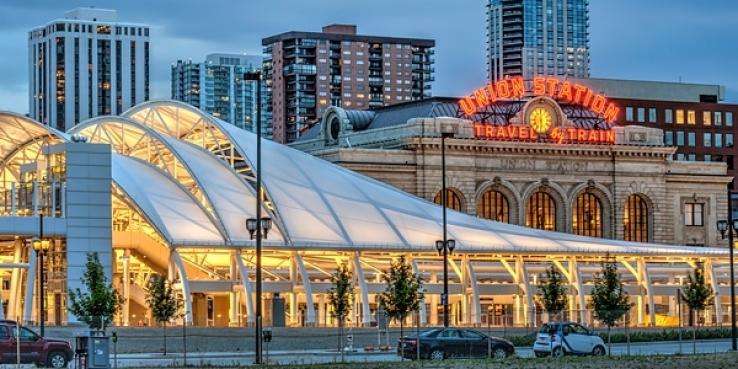Since Denver Union Station reopened in 2014, it has become one of the nation’s best examples of a modern intermodal train station embedded in a transit-friendly urban neighborhood. What was once a dilapidated station with poor transit service in a largely abandoned neighborhood is now a focal point of downtown in a neighborhood that is thriving. As planning gets underway for remaking San Jose’s Diridon Station into a major transportation hub with the country’s first high-speed rail station, SPUR is looking at other stations around the world for best practices and cautionary tales. Along with Rotterdam Centraal and Toronto’s Union Station, Denver has some important lessons for Diridon.
The Remaking of Denver Union Station
Denver Union Station’s transformation involved four large projects:
- Restoring and redeveloping the century-old station building, which had fallen into disrepair by the 1980s.
- Implementing FasTracks, a plan to build 122 miles of commuter rail and light rail in the Denver metropolitan area, with the station at its core.
- Creating a new home for Denver’s buses in a 22-bay underground bus terminal that is three football fields long.
- Redeveloping 19.5 acres around the station. The station is a 15-minute walk from the downtown core but, as at Diridon, the area around the station itself was mostly surface parking.
Marked by an iconic neon sign, the postcard image of Denver Union Station is its historic station building. The building is owned by the Denver Regional Transit District, or RTD. With the help of a committed stakeholder group, RTD developed clear redevelopment goals for the building and put out a request for proposals for a development partner. The Denver Union Station Alliance was selected as the RTD’s development partner and today holds a 99-year lease on the building. As part of the project, the alliance invested more than $35 million in the building and committed to share with RTD 7 percent of revenues over $12 million — a threshold that was quickly exceeded.
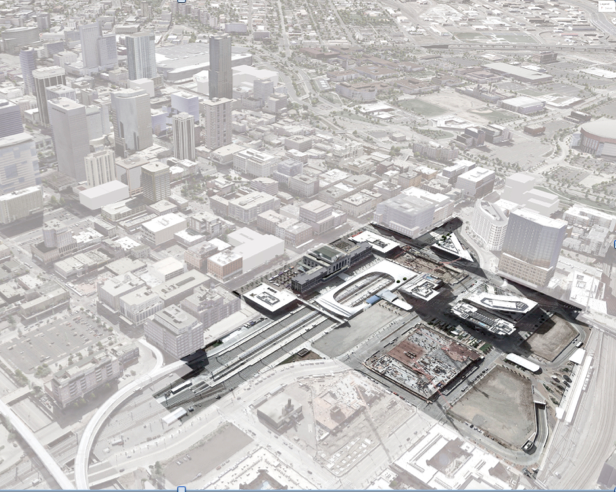
Before the station was redeveloped, the area around Denver Union Station was largely surface parking. Now the neighborhood has filled in with 20 buildings completed and under construction. Image courtesy of SOM.
The alliance did intensive market research to custom curate the historic building’s offerings. The research showed that people wanted the station to be a place that they could use daily and show to out-of-town visitors. The result is a set of shops, bars, restaurants and outdoor public spaces that are full of Colorado pride.
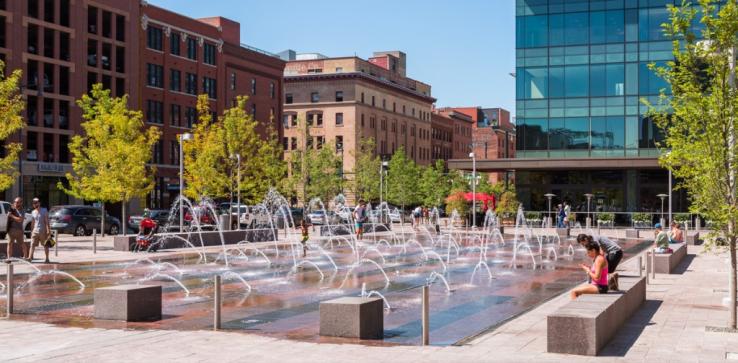
New public plazas and public spaces ring the station, providing flexible space for outdoor, play, farmers markets and seating. Image courtesy East West Partners.
As at Diridon, the redevelopment of Denver Union Station was a long time in the making. And, just as high-speed rail is inspiring Diridon’s redevelopment, an ambitious new transit program initiated the Denver megaproject. It started with a vision in the 1980s that became real in 2004 with a ballot measure that provided the funding for FasTracks, a comprehensive plan for adding light rail and commuter rail to the metro area.
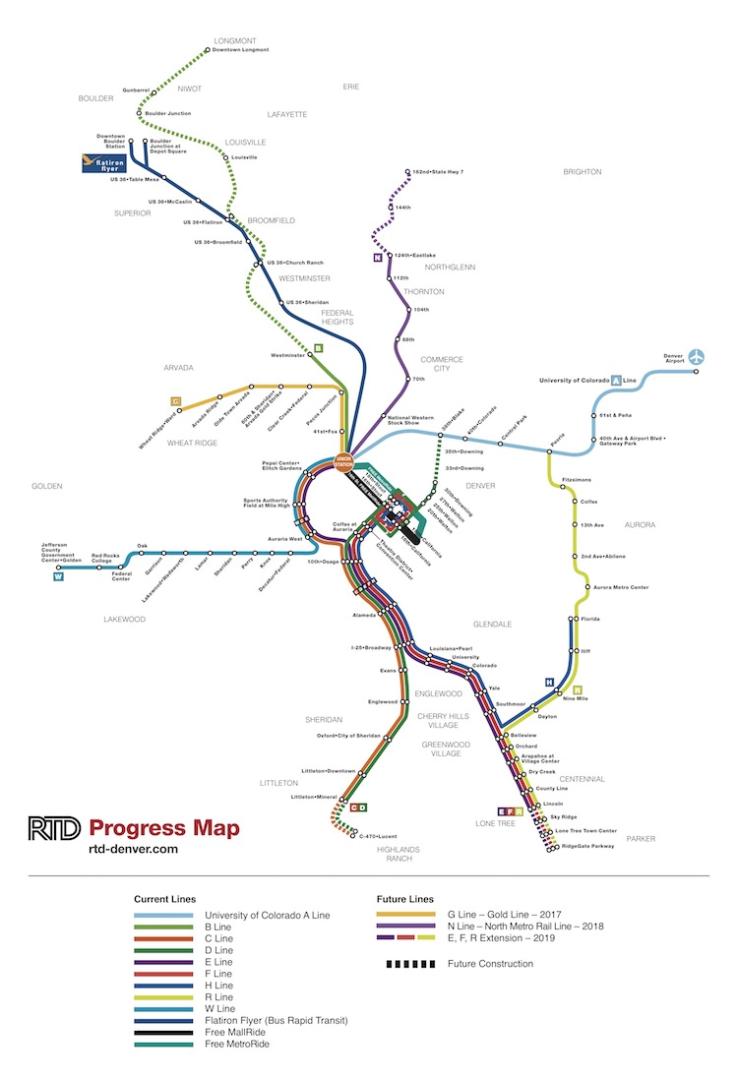
Denver Union Station is at the center of the region’s light rail and commuter rail network. This means the station and the area around it must work as a major destination. It’s important to note that Diridon is not the terminus of a regional network: It will be a “through” station that will need to serve people who are traveling and transferring to other places, with direct and intuitive connections and passenger-serving amenities. Image courtesy of Regional Transportation District, Denver.
Remaking Denver Union Station also involved redeveloping 19.5 acres of land north and west of the station. Today, there are 20 development projects under construction or complete within a half-mile of the station, totaling almost 2 million square feet of office space and more than 3,000 units of housing.
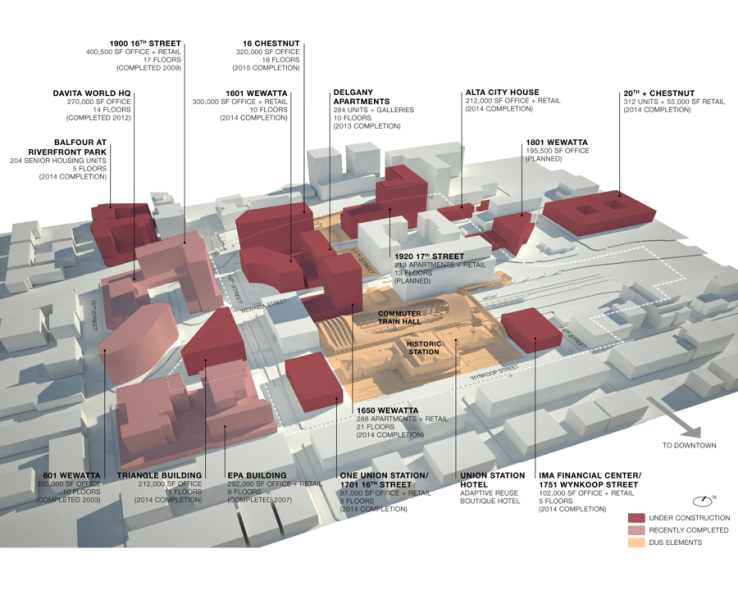
Surface parking lots made up the bulk of the station area at the start of the planning and redevelopment effort. Today, there are nearly 20 buildings under construction within a half-mile of the station. Image courtesy of Skidmore, Owings and Merrill.
A Success Story That Almost Didn’t Happen
None of these ultimately successful projects were certain in the beginning. Despite passing a sales tax in 2004, the county was deeply affected by the Great Recession just a few years later. Sales tax revenue is often not enough to fund megaprojects, so cities sell bonds based on the tax revenue — but no one was buying bonds during the recession. In 2008 it became clear that Denver and RTD would not have enough money to build the ambitious transit and development program they had planned. Consequently, RTD and and its partners — the City and County of Denver, the Denver Regional Council of Governments, the Colorado Department of Transportation and the master developer, the Union Station Neighborhood Company — had to come up with a creative financing solution to fund the project. The partners worked together to secure a unique federal funding package that included two federal loans from the Department of Transportation. This was the first time in history that these two loan programs, the Transportation Infrastructure Finance and Innovate Act and Railroad Rehabilitation and Improvement Financing, had been combined to fund a single project.
The 2004 master plan for Denver Union Station laid out a shared vision for the station and station area. It acknowledged the need for new governance structures to successfully deliver the vision, such as assembling and entitling land, implementing policy, overseeing design and construction, creating a forum for public participation and managing project financing. Five new organizations were created, with focused mandates and membership from both the public and private sectors. These new organizations included:
- The Denver Union Station Project Authority, a government special purpose entity established to manage, finance and implement the Denver Union Station Project. It includes representatives from the Colorado Deparment of Transportation, the Regional Transportation District, the Denver Regional Council of Governments, the City and County of Denver, and the metro district (see below).
- The Downtown Denver Authority, an entity with the ability to assemble land and assess and collect tax-increment on development in the 40 acres around the station (beyond the 19.5-acre station district). The city and county remit tax-increment to this authority, and it pays down some of the debt associated with improvements in the station area.
- The Union Station Neighborhood Company, composed of the two master developers for the station area: East West Partners and Continuum Partners.
- The Union Station Alliance, composed of the teams that restored and adapted the historic station building and that manage its hotel, retail, and food and beverage amenities. Members included Sage Hospitality and Larimer Associates.
- The metro district, which is essentially a special district where property owners contribute to providing public infrastructure or services such as building and maintaining sidewalks and parks. In addition to these traditional roles, members of each metro district also provided design review on proposed developments, using peer pressure to create good design as each parcel was built out.
Why It All Works
Denver committed to a single, shared vision that wasn’t weighed down by constraints and uncertainties. The 2004 master plan was a single, shared vision jointly produced by the public agencies. When the financing plan broke down with the Great Recession in 2008, the team members had to go back to the drawing board and develop a strategy that would help them achieve their goals without too many compromises.
To overcome financial challenges, RTD and its partners got creative about financing. They decided to bring in the private sector to help fund some of the placemaking and transit improvements. This project could not have been built without private sector investors to balance public financial risk. Additionally, the private sector investors were better equipped to handle some functions, such as retail programming and operations.
In this partnership, public and private risk was shared. RTD — a public agency — put skin in the game by waiving rent until the historic building’s gross revenues exceeded $12 million — a benchmark that was reached far ahead of schedule because of the station’s success. This agreement made it incumbent on RTD to design a transit system that worked well enough to encourage a lot of people to take the train and come through the station.
All the public and private partners came together to update the master plan and develop a single budget for the project as a whole. Together, they secured a unique federal funding package that included funding from the Department of Transportation — the first of its kind.
As funding for Caltrain and California high-speed rail grows increasingly precarious, it will be important for all of the public agencies to work together to deliver the redevelopment of Diridon.
Denver developed the right governance structure to implement its vision. The 2004 master plan called for a new governance structure to implement the shared vision. This approach has inherent advantages. It avoids piecemeal planning and also helps to identify important gaps. For example, everyone thinks it’s a good idea to have a central station hall adjoining the Caltrain, BART and high-speed rail platforms with a bus terminal, but this is not yet in the scope of any agency’s project. Whose responsibility is it to plan, fund and build this central hall? Remaking Diridon Station will not just be about bringing BART and high-speed rail into the station, but about fully rethinking how the station and station area function and feel.
The station is a place people want to spend time in whether or not they’re boarding a train. Denver’s historic station building has created a real place in an area that could otherwise be dominated by transportation infrastructure. The station was carefully curated with great outdoor plazas and businesses that have shaped and showcased Denver’s food culture, making it a place that draws people to the station for many reasons.
Conclusion
In some ways, Denver is an imperfect analog for Diridon. It doesn’t have high-speed rail, its station area is one-sixth of Diridon’s (19.5 acres compared to 240), and it’s the end-of-the-line for most trips in Denver. But Denver does offer a number of lessons for implementing a megaproject in the face of many uncertainties. For Diridon, many of the biggest questions around governance have yet to be resolved. How will major investments in the pedestrian network, a central station hall and public spaces be funded? How will we make sure that transit service is integrated and seamless, so it becomes a more attractive option for people to get where they need to go? What will be the bridge between today’s development opportunities and the long-term vision? Denver offers one model of how to solve some of these complex challenges.
About the Authors
Laura Tolkoff is SPUR's San Jose Policy Director. Alex Shoor currently works with Katz & Associates and completed this work for SPUR as a special projects assistant earlier this year. Kenichiro Suzuki is an associate at Skidmore, Owings and Merrill.
